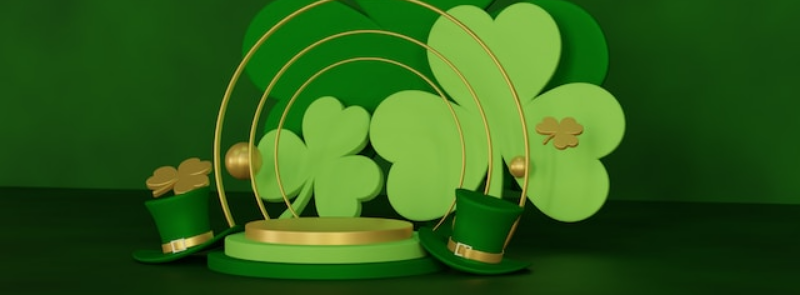
When It Occurs
Every March 17th
Timeline
Days Passed (1018)
# Hashtags
#SaintPatricksDay #IrishCulture
Saint Patrick's Day, observed annually on March 17th, is a religious and cultural celebration dedicated to honoring Saint Patrick, the patron saint of Ireland. The holiday holds significance in commemorating the introduction of Christianity to Ireland and serves as a festive occasion to celebrate Irish culture and heritage. Legend has it that Saint Patrick wielded his powers to banish all the snakes from Ireland, a tale often depicted in old statues of Saint Patrick in the country, with snakes at his feet.
History and Origins
Saint Patrick:
- Saint Patrick is the patron saint of Ireland. He was a 5th-century missionary credited with converting the Irish to Christianity.
- Born in Roman Britain, he was kidnapped at the age of 16 and taken to Ireland as a slave. He later escaped but returned to Ireland and played a significant role in spreading Christianity.
- Legend says he used the three-leafed shamrock to explain the Holy Trinity (Father, Son, and Holy Spirit).
Origins of the Celebration:
- The day marks the anniversary of Saint Patrick's death, believed to be on March 17, 461 AD.
- Originally a religious feast day in the 17th century, it has evolved into a global celebration of Irish culture and heritage.
Traditions and Celebrations
Religious Observances:
- In Ireland, the day begins with church services and prayers. It's a day of spiritual renewal and offering prayers for missionaries worldwide.
Parades and Festivals:
- Major cities around the world, including Dublin, New York, Boston, Chicago, and Sydney, host parades featuring marching bands, bagpipers, dancers, and floats.
- The first recorded parade was held in New York City in 1762 by Irish soldiers serving in the British army.
Wearing Green:
- Green is associated with Saint Patrick's Day because of Ireland's nickname, "The Emerald Isle," and the green in the Irish flag.
- People often wear green clothing and accessories, and it's common to see shamrocks pinned to their clothes.
Food and Drink:
- Traditional Irish foods like corned beef and cabbage, Irish stew, and soda bread are popular.
- Beer, particularly Guinness, and Irish whiskey are widely consumed. Some people dye their drinks green to match the festive spirit.
Cultural Activities:
- Irish music and dance performances, including traditional instruments like the fiddle, tin whistle, and bodhrán.
- Many cities dye rivers and fountains green to celebrate. The Chicago River is famously dyed green each year.
Symbols of Saint Patrick's Day:
- Shamrock: Associated with Saint Patrick's teaching of the Holy Trinity.
- Leprechauns: Rooted in Irish folklore, these mischievous fairies are a symbol of luck.
- Green: Symbolizes spring, the Irish landscape, and the Irish flag.
Global Observance
Ireland:
- A public holiday with parades, festivals, and religious services. Dublin hosts one of the largest celebrations, featuring a multi-day festival.
United States:
- Saint Patrick's Day is widely celebrated due to the large Irish-American population. New York City hosts the largest parade, drawing millions of spectators.
- Cities like Boston, Chicago, and Savannah also have significant celebrations, including parades, river dyeing, and cultural events.
Canada:
- Celebrations include parades, especially in cities with large Irish communities like Toronto, Montreal, and Vancouver.
- The day is marked by Irish music, dance, and cultural events.
Australia and New Zealand:
- Parades and festivals are held in cities such as Sydney, Melbourne, and Auckland.
- Irish pubs and cultural organizations host events, including music, dance, and traditional food.
Other Countries:
- Countries with Irish expatriates and descendants, such as the UK, Argentina, and Japan, also celebrate with parades, cultural events, and gatherings.
Modern Influence
Commercialization:
- Saint Patrick's Day has become highly commercialized, with themed merchandise, food, and beverages widely available.
- Companies often use the holiday for marketing campaigns and promotions.
Cultural Impact:
- The day has transcended its religious origins to become a celebration of Irish culture and identity.
- It promotes cultural exchange and understanding, bringing people of various backgrounds together to celebrate Irish heritage.
How to Get Involved
Attend Parades and Events:
- Join local parades, festivals, and cultural events to experience the festivities.
Wear Green:
- Dress in green attire and accessories to show your participation in the celebration.
Try Irish Cuisine:
- Prepare or enjoy traditional Irish dishes like corned beef and cabbage, Irish stew, and soda bread.
Enjoy Irish Music and Dance:
- Listen to Irish music, watch dance performances, or even try learning some traditional Irish dances.
Learn About Irish Culture:
- Use the day as an opportunity to explore Irish history, folklore, and traditions.
Saint Patrick's Day is a vibrant celebration of Irish heritage and culture, enjoyed by people worldwide. Whether through parades, music, food, or simply wearing green, it is a day to honor the legacy of Saint Patrick and the rich traditions of Ireland.


